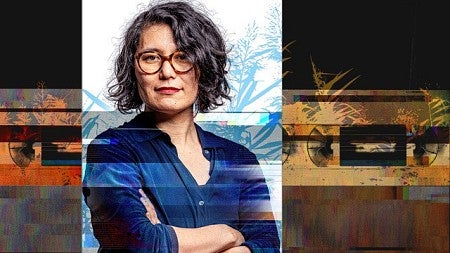
Fighting the “Parallel Pandemic”
Student’s Twitter feed is antidote to rapid spread of COVID-19 misinformation
By Tim Christie • October 7, 2020
3 min read
As spring term approached in the midst of the coronavirus pandemic, University of Oregon senior Myriah Kunipo-Aguirre found herself hunkered down at her parent’s house in Carson, California.
She needed to complete field work for her global health minor, but the UO canceled travel and internship programs as it grappled with the spread of COVID-19.
Kristin Yarris, director of the Global Health Program, recognized the problem confronting Kunipo-Aguirre and other students. She quickly launched a course called Global Health Crisis to give students a chance to complete required field experience where they resided.
Kunipo-Aguirre tracked the outbreak in her own backyard—Los Angeles County—using Twitter to report on the emergency response of state and county officials. With 10 million residents, Los Angeles County is the most populous county in the country, and among the first to impose lockdown measures intended to slow the spread of COVID-19.
Kunipo-Aguirre created a Twitter feedand posted news that drew from myriad sources, including state and county health departments, the Centers for Disease Control and Prevention, elected officials, and news outlets. She also kept track of how the pandemic was hitting various industries, such as sports and tourism, both huge drivers of the Southern California economy.
“It’s been very overwhelming with all the news,” she says. “I wanted to create an accessible, organized information outlet for anyone in the community.”
Along with links to news stories and press releases, Kunipo-Aguirre included her own commentary and observations. When an Orange County supervisor pushed back against the governor’s order to close beaches, calling it an overreaction, she tweeted, “We will never know if we overreacted, but we will know if we didn’t do enough. #FoodForThought #COVID19”
Once a week, she compiled an update on the latest developments. The feed reads as a real-time chronicle of an unfolding pandemic, from the state’s on-and-off efforts at closing and opening beaches, to a running tally of cancelled events and festivals, to news you can use, such as the latest public testing sites.
Kunipo-Aguirre, who graduated in the spring with a degree in human physiology and minors in anthropology and global health, plans to pursue a graduate degree in public health starting this fall at the University of San Francisco.
Yarris was impressed by Kunipo-Aguirre’s use of Twitter, which allowed the student to develop her own voice and analysis of the pandemic.
“It is crucial that young voices use social media platforms to spread sound public health information to counter the widespread misinformation circulating on these platforms,” says Yarris, “which some observers have called a ‘parallel pandemic.’”
Kunipo-Aguirre presented her work at the UO Undergraduate Research Symposium, which was held online due to the pandemic. President Michael Schill participated, posing a question about what university presidents should consider in reopening campuses.
“Myriah handled the question like a pro, pointing out aspects of public health prevention from a student’s point of view, and balancing health, economic, and social concerns,” Yarris says.
Tim Christie is a staff writer for University Communications.




